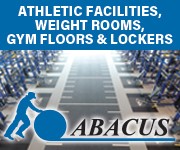As a self-confessed cinephile, I openly admit to having a favorite swimming pool scene, and it’s one that perfectly captures the ennui of Bill Murray as a lonely, jaded tycoon in Wes Anderson’s great Rushmore.
Murray’s character, known otherwise as Herman Blume, listlessly tosses golf balls into a pool during a children’s birthday party; he then cannonballs into the greenish water while children swim around him, his cigarette still hanging flaccidly from his lips. Blume is lost in his own depressive universe, and for him, the pool may as well represent a void.
Thankfully, for the rest of us, swimming pools are great fun, a space for socialization and recreation, a refuge from the stresses we face each day. That swimming pools also serve as an environment where we can develop and maintain fitness levels adds to their versatile appeal and functionality.
Aquatic Facilities a Factor in Recruitment
At private universities and colleges across the country, on-campus aquatic facilities are a terrific means of capturing the imagination of prospective students, particularly for first-year and transfer students who are looking for the complete on-campus experience.
Aquatic facilities can be used for a range of activities beyond swimming, those such as water polo, water basketball, water aerobics, aqua jogging, among so many others.
Moreover, the facilities are an asset in the recruitment of student athletes who are invested in keeping their bodies and minds healthy.
A top-notch aquatic facility reflects an on-campus culture of fitness and well-being that speaks to the values that student-athletes not only care about but also need to sustain during their time with us.
Regular Exercise Means Happier Students
A 2016 study by Dr. Heather Sanderson and Dr. Jason DeRousie shows that physical activity equates to a higher likelihood of academic success.
The study measured recreational activities for 20,000 students, and at least two key discoveries were made:
First, “For every extra hour that students exercised, their odds of graduating (or returning the following year) increased by 50 percent.” Activities included swimming and other aquatics-based exercise, running, intramural sports, strength training, and/or taking group exercise classes.
Second, students had higher grade point averages when they exercised more frequently. For each hour of physical activity in a week, a student’s GPA went up .06 on the 4.0 scale.
In addition to the findings by Sanderson and DeRousie, the Harvard Health Letter reports that aerobic activity (including water-based ones), unlike strength training, can help the hippocampus part of the brain grow. The hippocampus handles learning as well as verbal memory, both of which are skills instrumental to academic success.
Of course, there are the indirect benefits of exercise and doing recreation activities, as well—those such as better sleep, a decrease in stress, and the release of feel-good endorphins.
What we’re learning is that exercise and recreation—and for our immediate interests here, aquatics-based ones—not only help to facilitate better health and wellness from students, but that students in turn do better academic work. Exceptional aquatics facilities bring prospective students to our institutions, keep current ones happy, and also have the potential to improve graduation rates.
Stellar Aquatic Facilities at Pepperdine & Nova Southeastern
Pepperdine University is known for its excellence in athletics, and its facilities reflect this tradition.
Its Firestone Fieldhouse gymnasium accommodates 5,000; the Ralph-Straus Tennis Center fully lights 19 courts, and it once hosted the NCAA Women’s Tennis Championships. Pepperdine’s Alumni Park is 30 acres of lush greenery, sloping hills, and scenic ponds.
But the aquatics facilities at Pepperdine are especially impressive. Let us marvel at the Runnels Swimming Pool, which once served as the location of Olympic water polo competitions.
The pool reaches a depth of 16 feet and is massive in size, covering eight lanes that run the long course and seventeen that run the short course. It contains one and three-meter diving boards, not to mention a Jacuzzi for students to enjoy following a workout.
Nova Southeastern University, located 24 miles north of Miami, has embraced its aquatics facilities as an essential component of the on-campus experience. Students who live in Rolling Hills Graduate Apartments, for instance, have direct access to the Rolling Hills Residential Leisure pool.
It is a “resort style” pool, one beautifully landscaped with rocks and a waterfall, and equipped with indoor lounge space and a covered outdoor pavilion. In addition to having a “zero entry” point, the waterfall and heating mechanisms of the pool are powered by solar panels.
The main leisure pool at Nova Southeastern is a ½ Olympic-sized pool that ranges up to five feet in depth. Located outside of the Don Taft University and RecPlex gym facility, this 50-meter pool is temperature-controlled throughout the year; it can be set up for 50-meter or 25-yard lap swimming, and it contains two one-meter and one three-meter diving boards.
Moreover, it is the largest competition pool in the state of Florida with well over one million gallons of water.
Aquatics facilities can be used as a hub for our students to interact, to exercise and have fun, to decompress after a stressful exam, or even to find focus prior to an exam. Something as simple as swimming a few laps can unburden students from any nervous energies that may get in the way when exam time comes.
Across the country, private universities and colleges are seeing the benefits of providing stellar aquatics centers. The benefits are wide-ranging, and they appeal to students, both current and prospective.










